Many businesses nowadays are turning to digital marketing as a way to stand out in a crowd. Those same businesses are also evaluating SEO vs. PPC to determine which strategies will yield the most effective results. They want to get the most ‘bang for their buck’, which means picking the best strategy for them.
There are two predominant approaches to marketing: Search Engine Optimization (SEO) and Pay-Per-Click (PPC) advertising. Each strategy has its own pros and cons, meaning choosing the right strategy for your business depends on individual factors, including business goals, budgets, and industry dynamics.

First, SEO is the practice of optimizing your website to increase its visibility in organic search engine results. This is done by improving website elements such as content, including blogs and on-site copy, meta tags, headers, and building backlinks that align with search engine algorithms. This method is often seen as a long-term strategy that builds credibility and trust over time, improving overall search results.
PPC, on the other hand, uses paid advertisements to appear higher in search engine result pages (SERPs). Advertisers bid on keywords, and each time their ad is clicked, they pay a fee. This form of advertising is instant and versatile, allowing businesses to reach audiences quickly and effectively. However, once you stop paying for clicks, traffic can drop dramatically, meaning it isn’t a solution that is as long-term as SEO.

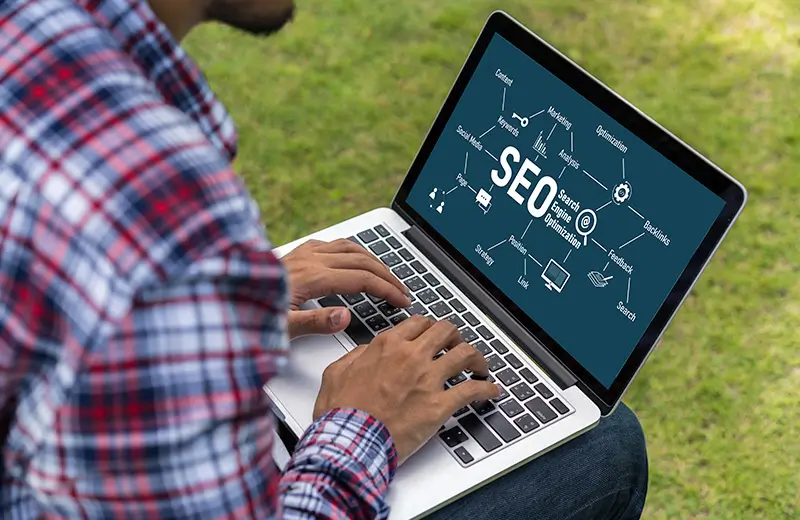
Want to learn why SEO is crucial for small businesses? Check out our recent blog.
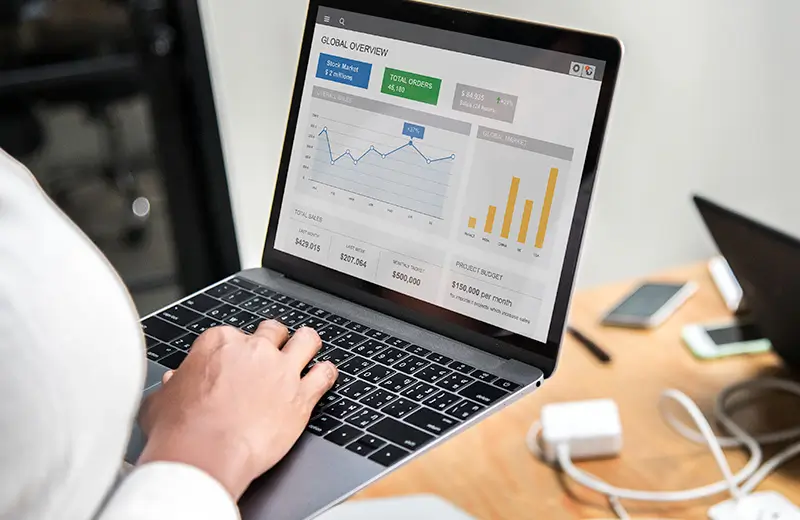
When it comes right down to it, choosing between SEO and PPC really depends on your business and what you need in both the short and long term. If you want immediate visibility and can afford ongoing advertising, PPC can be a powerful strategic tool. It is also especially helpful for new product launches or targeting specific demographics quickly.
On the other hand, if you want a more long-term online presence and have the time and energy to dedicate to growth, then SEO can be equally advantageous. It creates a foundation of organic, ongoing traffic that can build on itself without constant and active oversight.
For many businesses, the right approach might not be solely SEO or PPC but rather a hybrid approach. Balancing long-term growth with immediate impact will create a comprehensive digital marketing strategy that adapts to different goals and market conditions, benefiting the business in the long run.
Ultimately it is by aligning these strategies with your unique business objectives that is going to be what guides your path towards digital success.
We offer SEO services in collaboration with our partners at Lucent Creative, a female-led digital marketing agency. Need a hand getting your business on the (local) map? Book a free consultation.
If you're running a business and looking to grow your online presence, you've probably heard the term "digital marketing funnel." It might sound like marketing jargon, but a digital marketing funnel is one of the most powerful tools to attract potential customers, guide them through their buying journey, and convert them into loyal clients.
So, what exactly is a digital marketing funnel, and why do you need one? Let’s break it down.

A digital marketing funnel is the path your potential customers follow from the moment they first discover your brand to when they make a purchase (or even beyond). It’s called a “funnel” because, like a real funnel, it narrows down as people move through the stages. At the top, you’ve got a broad audience that may not know anything about your business, and by the time you get to the bottom, you have a smaller, more focused group ready to take action.
The key stages of a digital marketing funnel are:
Let’s dive into each stage and talk about how to guide potential customers through this journey.
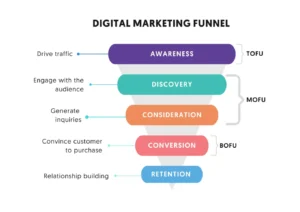
Image credit: reliablesoft
This is the first stage, where people are just becoming aware of your business. They might be facing a problem or have a need, but they don’t know yet that you have the solution. Your goal here is to get your brand in front of as many eyes as possible and make a good first impression.
How to do it:
At this stage, your audience isn’t ready to buy yet—they’re just learning who you are. Your goal is to provide value and catch their attention.

Now that potential customers are aware of your business, they start considering their options. This is where you build trust and show them why you're the best choice to solve their problem or fulfill their need. They might be comparing you to competitors or looking for more information.
How to do it:
This is also a good time to nurture your leads with email marketing campaigns, offering them more value and gently guiding them toward making a decision.
At this point, your leads are ready to make a decision. They’ve learned about your brand, compared their options, and now they’re on the verge of converting into paying customers. This is the most crucial part of the funnel, so your job here is to give them the final nudge.
How to do it:
Your goal here is to make the buying decision as easy as possible and eliminate any doubts they might have.
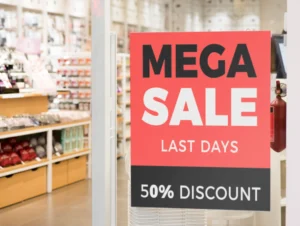
Congratulations! Your lead has now become a customer. But your job isn’t done yet—this is where the magic of turning a one-time buyer into a loyal customer comes into play. You’ve guided them through the funnel, and now it’s time to deliver a great experience and ensure they’re satisfied with their purchase.
How to do it:
By delivering an exceptional experience after the sale, you increase the chances of your customer returning and recommending your business to others.

Many businesses focus on getting new customers, but don’t forget about the ones you already have! Keeping your customers engaged and coming back for more is a key part of any successful digital marketing funnel. Plus, repeat customers are often more valuable and cheaper to retain than acquiring new ones.
How to do it:
Retention not only leads to more sales but also builds long-term loyalty and can even turn your customers into brand ambassadors.

These days, customers have more options than ever, and they don’t just stumble onto a purchase. They go through a journey—learning about their options, weighing pros and cons, and deciding who to trust. A digital marketing funnel helps you meet your potential customers where they are and gently guide them through each step of the buying process.
By creating a strong funnel, you’re not only increasing your chances of making a sale but also building lasting relationships with your audience. Whether you’re a small business or a growing brand, a well-structured digital marketing funnel is essential to turning visitors into leads and leads into loyal customers.
Our partners at Lucent Creative, a female-led digital marketing agency, help business owners like you set up marketing funnels that convert and boost revenue. Book a free consultation to get started!
If you're a small business owner, attracting local customers is key to growing your business, highlighting the importance of SEO. Whether you're running a café, a boutique, or a service provider, you want the people in your area to find you easily and choose you over the competition. That’s where local SEO (Search Engine Optimization) comes in.
Local SEO helps your business appear in online searches when people are looking for products or services nearby. Think of it as making sure your business pops up when someone searches for something “near me” on Google. Here’s why it’s super important for your business and how you can start using it to get noticed.

The main reason to focus on local SEO is to help your business show up higher in search results when people in your area are looking for what you offer. For example, when someone types in “best pizza near me” or “plumber in [your town],” you want your business to be at the top of the list.
If you aren’t optimizing your website or Google Business Profile, you're missing out on potential customers who are actively searching for services like yours. Local SEO helps you get noticed in these searches, which can land you a spot in the Google Map Pack—that highly visible map and business listing that shows up before any regular search results.
According to Google, 76% of people who search for something nearby on their phone visit a business within a day. That’s a huge opportunity! By optimizing for local SEO, you’re making it easier for people to find your business, see your hours, read your reviews, and get directions—all of which make it more likely they’ll visit you in person.
Local SEO literally puts your business on the map for customers ready to stop by and make a purchase.

Showing up consistently in local search results does more than increase visibility—it builds trust. When potential customers see your business listed at the top of their search, along with solid reviews, it signals that you’re a credible and trusted option in the area.
Encouraging happy customers to leave positive reviews is a great way to boost your online reputation with the local community. Over time, this can help you stand out as the go-to business in your area.
We know it can feel tough to compete with larger businesses with bigger marketing budgets, but local SEO gives small businesses an edge. While national companies might dominate broad searches, local SEO helps you shine when it comes to location-specific searches.
For example, while you might not beat a big-box store for “buy tools online,” with the right local SEO strategy, your hardware store can easily rank at the top for “hardware store in [your town].” Local SEO helps you go toe-to-toe with bigger brands, especially when it comes to your specific area.

Now that you know how important local SEO is, let’s talk about how to implement it. Here are some simple steps to help your business get found by local customers:
This is the big one! Make sure you claim your Google Business Profile and fill it out completely. Add all the relevant details, like your business name, address, phone number, website, hours, and services. Make sure everything is accurate and consistent across the web.
Positive reviews can give your local SEO a serious boost. Encourage your happy customers to leave glowing reviews on Google, Yelp, and other platforms. The more high-quality reviews you have, the better you’ll rank.

Incorporate location-specific keywords into your website’s content. For example, instead of just saying “best bakery,” try “best bakery in [your town]” to help Google understand where you’re located and match you with nearby searches.
Many local searches happen on phones, so your website needs to work well on mobile. Make sure it loads quickly, is easy to navigate, and has all your key info (like contact details and hours) right up front.

Try adding a blog or news section to your website that focuses on local events, collaborations, or other community-related topics. This will help you rank better in local searches and build a stronger connection with your audience.
Local SEO is a game changer for small businesses. It helps you get noticed by nearby customers, build trust in your community, and even compete with bigger brands. If you haven’t started working on your local SEO yet, now’s the time! With a little effort, you can attract more customers, drive more foot traffic, and grow your business right in your own neighborhood.
We offer SEO services in collaboration with our partners at Lucent Creative, a female-led digital marketing agency. Need a hand getting your business on the (local) map? Book a free consultation.
Marketing trends are constantly evolving.
Change is the one “trend” you can count on in digital marketing. As technology continues to evolve at lightning speed, so do the preferences and behaviors of consumers.
Enter Gen Z, the digital natives born between the mid-1990s and early 2010s, who are reshaping the landscape of digital marketing and tech in general. In this blog post, we'll explore why SaaS companies need to start marketing to Gen Z and how they can do it most effectively. We reached out for a little help from our friends over at Lucent Creative Co., a woman-owned marketing agency.
Well, let's start with the basics.
Gen Z is the first generation to grow up entirely in the digital age.
They've never known a world without smartphones, social media, or on-demand streaming services.
Fun Fact: Remember the whole thing where you mailed DVDs back and forth to Netflix? Yeah, you just blew the mind of a Gen Z.
One of the key reasons SaaS companies should start marketing to Gen Z is their sheer purchasing power. Gen Z represents a lucrative market opportunity that cannot be ignored. But it's not just about their wallets; it's also about their influence.
Cue the term influencer.
Gen Z wields significant influence over household spending decisions, often playing a pivotal role in shaping the purchasing behaviors of their parents and peers. They are trendsetters, early adopters, and champions of brands that align with their values and resonate with their digital-centric lifestyles. For SaaS companies looking to gain a competitive edge, winning over Gen Z could be the key to long-term success.

Let's delve into some key insights with Kendall Walker, CEO of Lucent Creative Co.
We asked Kendall for her insight on what makes Gen Z tick, and she shared the five attributes SaaS companies should present to make a splash in the Gen Z marketing pool.
Gen Z craves authenticity above all else.
“The Gen Z demographic has little patience for brands that try to be something they're not. Honesty and authenticity are the keys to engaging Gen Z.”, Kendall shares.
SaaS companies must prioritize transparency, honesty, and genuine connection in their marketing efforts. Whether it's through user-generated content, influencer partnerships, or behind-the-scenes glimpses into company culture, authenticity should permeate every aspect of the brand's messaging.
Pro Tip: Give your email campaign a makeover for further reach. Learn more.

For Gen Z, the smartphone is their lifeline to the world—communicating, researching, shopping, and even social activism. They spend an average of over four hours per day on their mobile devices, consuming content, communicating with friends, and making purchasing decisions on the go.
“SaaS companies need to optimize their websites, apps, and marketing materials for mobile-friendly use. Failing to do that is a huge waste of time and money for SaaS companies—any business, really.”, says Lucent Creative’s CEO.

“I see a lot of resistance to keeping up with trends in marketing. The truth is, that resistance is costing businesses sales potential. You don’t have to fully align with a trend, but effort is a major way forward with Gen Z.”, Kendall shares.
Gen Z is a visual generation, raised on a steady diet of Instagram stories, TikTok videos, and Snapchat snaps.
They prefer bite-sized, visually appealing content that grabs their attention and communicates a message quickly and succinctly. SaaS companies can leverage visual storytelling techniques such as videos, infographics, and interactive multimedia to convey their value proposition compellingly and memorably. By prioritizing visual content that is both informative and entertaining, brands can effectively cut through the digital clutter and capture Gen Z's interest.
“A company aligned with a social cause is a step ahead of the competition when it comes to Gen Z. There has to be authenticity in supporting the cause. So, don’t just tie your company to a cause for the sake of clicks (remember, Gen Z can pick up on that!). Something I love most about Gen Z is their desire to make the world handed down to them a better place.”
Kendall Walker, CEO of Lucent Creative
Gen Z is acutely aware of social and environmental issues and expects the brands they support to share their values. SaaS companies should take a stand on issues that matter to Gen Z, whether it's sustainability, diversity and inclusion, or ethical business practices.
By aligning their brand with causes that resonate with Gen Z, SaaS companies can foster deeper connections and inspire loyalty among this socially conscious demographic.
Traditional sales tactics fall flat with Gen Z. They don't want to be sold to; they want to be engaged and empowered. SaaS companies should focus on building meaningful relationships with Gen Z through personalized, interactive experiences.
Whether it's hosting live Q&A sessions, facilitating user-generated content campaigns, or gamifying the customer journey, the key is to involve Gen Z in the conversation and make them feel like valued participants rather than passive consumers.
“One of my favorite aspects of marketing is helping my clients to find fun, authentic ways to engage with their audiences. It doesn’t have to be trending or even a “cookie-cutter” strategy to work. Remember, your voice as a company matters—tapping into it is just as important as your product/service.”, says Kendall.

Now is the time for SaaS companies to start marketing to Gen Z. With their unprecedented purchasing power, influence, and digital savvy, Gen Z represents a formidable force in the marketplace. By understanding their unique preferences, behaviors, and values, SaaS companies can tailor their marketing strategies to engage this dynamic demographic effectively and secure a competitive advantage in the ever-evolving digital landscape.
So, if you’re a SaaS company looking to future-proof your business and unlock new growth opportunities, it's time to shift your focus to Gen Z. Embrace authenticity, prioritize mobile experiences, leverage visual storytelling, champion social causes, and above all, engage with Gen Z on their terms.
The future of your brand depends on it.
You know we don’t leave things on such an ominous tone! Reach out to Kendall at Lucent Creative to get a hand with your marketing efforts!
Our friends at Lucent Creative, a woman-owned digital marketing agency, have a few tips for navigating marketing in 2024.
New year, new approach–it’s time to sharpen our content planning game. The days of throwing spaghetti at the wall and hoping it sticks are long gone. In this era of information overload, strategic content planning is the secret sauce for cutting through the noise and capturing your audience's attention.
So, grab your coffee, and let's embark on a journey into the future of content planning.

In 2024, it's all about understanding your audience on a personal level. Consumers are craving content that speaks directly to their needs, preferences, and pain points. Start by diving deep into your audience personas – who are they, what keeps them up at night, and how does your content make their lives better?
Leverage data analytics and social listening tools to gain insights into your audience's behavior. What are they clicking on? What are they sharing? Understanding your audience's digital footprint is key to creating content that resonates. Personalization is the name of the game, and the more you know about your audience, the better you can tailor your content to meet their expectations.
Bonus! Master your social media campaign with this blog post.
Static content is no longer enough; your audience wants to be a part of the experience. From quizzes and polls to interactive infographics and 360-degree videos, the possibilities are endless. Interactive content keeps your audience engaged and invested in your brand.
Make interactive elements a priority in your 2024 content calendar. Host live Q&A sessions, create polls on social media to gather opinions, etc. The more you can involve your audience in the content creation process, the more connected they'll feel to your brand.

In the age of information overload, quality trumps quantity. In 2024, it's not about bombarding your audience with a constant stream of content. It’s about creating meaningful, high-quality pieces that add value. Invest time in researching and producing well-crafted content that solves problems, educates, or entertains. Whether it's a blog post, video, or podcast episode, make it worth your audience's time. Consumers are looking for substance and authenticity.
If video content wasn't at the top of your content planning list before, it should be now. Video content is no longer optional; it's essential for capturing and retaining audience attention. Whether it's short-form content for social media or long-form storytelling on YouTube, video is the medium of choice for many consumers.
Incorporate a variety of video formats into your content strategy. Think about how-to videos, behind-the-scenes glimpses, customer testimonials, and even interactive live streams. Video not only allows you to convey information more dynamically but also helps humanize your brand and establish a deeper connection with your audience.

Bonus! Read about optimizing your blog with video in 2024 here.
Search Engine Optimization (SEO) is still a crucial element of content planning in 2024. The way people search may evolve, but the importance of being discoverable on search engines remains. Keep a keen eye on emerging SEO trends, such as the rise of voice search and the continued emphasis on user experience.
Craft content with relevant keywords, but prioritize natural language and readability. Google's algorithms are getting smarter, and they're favoring content that provides a good user experience. Focus on creating content that answers questions, solves problems, and keeps users engaged – this will naturally boost your SEO rankings.
Artificial Intelligence (AI) isn't just for sci-fi movies; it's a game-changer in the world of content planning. AI can analyze data, predict trends, and even suggest optimizations for your content strategy.
Explore AI-powered tools for content creation, such as automated writing assistance or image recognition for visual content. AI can help you understand what content is resonating with your audience, predict future trends, and optimize your content strategy for maximum impact. It's like having a digital ally that guides you through the ever-evolving landscape of content creation.

From understanding your audience on a personal level to embracing interactive and high-quality content, the rules of the game are evolving. Video is king, SEO is still relevant, and the power of AI and UGC is undeniable. So, roll up your sleeves, stay agile, and embark on your content odyssey armed with the trends that will shape the narrative in 2024.
Need a hand with content in 2024? Get in touch with Lucent Creative’s team of marketing professionals.
Blog posts aren’t obsolete. If so, then we’d be wasting our time writing this and you would be wasting your time reading it, right? Writing blog posts are a great way to increase website traffic, generate leads, and showcase your expertise. Readers also get a closer look at your brand and learn to trust your validity as a service provider or eCommerce store. Of course, not all blog posts are well-written and won’t perform well in a search engine. We teamed up with our partners over at Lucent Creative, a woman-owned digital marketing agency, to bring you the best tips on writing blog posts that convert.
We asked Lucent Creative’s copywriter and content writer Nikki for more insight on the five mistakes to avoid when writing blog posts.

Just because your blog post covers a wide subject doesn’t mean it will pique the interests of a wider audience. Know your ideal reader, or target audience, and create content exclusively for them.
Nikki shared, “It’s tempting to take a trending topic and write broadly about it. If anything, you imagine it would rank well in search engines since it’s a popular subject. The truth is, that you always want to optimize your writing for your ideal customer. There are a lot of books out there, but authors choose a genre, then a sub-genre, and then continue to specify down to the demographic they’re writing for. The same is true for writing blog posts.
Know your audience and know them incredibly well. It affects the language you use when writing, how you speak to their needs, and of course, how successfully your blog performs once it’s out in the world.”
Utilize Alt text on photos and other visuals in your post. It’s not only helpful for SEO optimization but is also considerate of your readers who may be visually impaired.
“The trick with alt text is to keep it concise. Bring out the most vital aspects of the photo with as few words as possible. Thankfully, many stock photo sites have already provided alt text for you.”, Nikki says.
The example below shows that Pexels, a stock photo and video site, provides alt text in the URL. Nikki adds, “Make sure you look at the URL or texts provided by these sites so you can optimize them for your blog. Some photos may have alt text that is too general.”

“Formatting is one of the biggest mistakes people make in their blog posts. Attention spans are short and you want your audience to get the most from your writing at a glance.”
The ideal blog post will be easy to read. Formatting is one of the most important aspects of a blog that performs well.
A call to action is crucial in creating a blog that generates leads. A confused audience won’t take the intended next steps unless you show them how.
“Make sure your CTA matches your blog topic. When writing blog posts, it’s also important to link your CTA to the appropriate page. If your blog is educating the audience on your newest app feature and your CTA is “Download Now”, but the CTA button is linked to the “About Us” page then that complicates the reader’s journey. Your audience will bail if the CTA isn’t seamless.”, Nikki instructs.
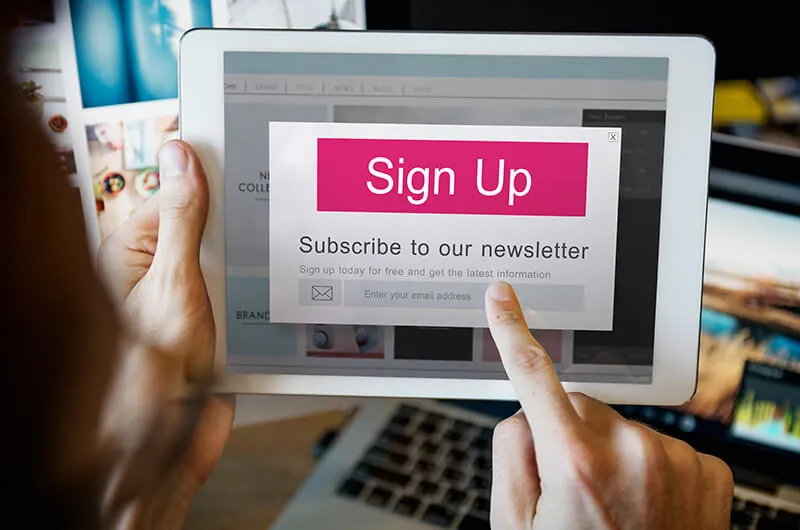
This one is huge. Include backlinks in your posts to relative information you have created in the past. Woggle does this often to optimize our posts.

Internal backlinks have multiple perks, including:
Take a moment to think through your current blog content. Are the posts optimized with internal backlinks? It’s an easy fix and we recommend taking time to implement links in your content.

If your team needs a hand optimizing current content or writing blog posts that convert, get in touch with Lucent Creative’s team.
Nikki wraps up our interview with one last gem:
“Helping business owners connect with their audiences is one of my favorite aspects of my job. They have worked hard to build something their passionate about and they deserve to foster the leads they deserve. I get it–writing blog posts is one of those business tasks people don’t necessarily look forward to or enjoy. Thankfully, I love what I do and Kendall’s team is always happy to help.”
Emails still rank at the top of the charts in marketing and are crazy-successful if you execute them correctly.
Even with new social media platforms bursting onto the scene at what seems to be daily, a good old-fashioned email campaign still performs the best. Here are a few stats from HubSpot showing just how big of a punch emails throw at the competing platforms.
These stats are proof that you have a willingly captive audience that your organization only needs to tap into.
So, how do you create an email marketing campaign that engages your audience, generates new leads, and increases revenue? Don’t worry. We reached out to our partners at Lucent Creative, a female-owned digital marketing agency, and they agreed to give you the exact formula for a wildly successful email marketing campaign!

“Casting a wide net with your email campaign isn’t the key to success. You want to be specific by setting an overall goal for each campaign.”, Lucent Creative’s Founder and CEO, Kendall Walker shares.
Here are a few examples of goals you can associate with your email campaigns:
Lucent Creative’s copywriter, Nikki Newbauer, spoke to the value of setting specific goals. “Knowing your overarching goal for the email campaign will create synchronicity for your creative team. Everyone from your copywriter to graphic designer will be on the same page which creates a clear and concise path for your readers to follow.”
Below are the general categories most email campaigns fall under.
The more specific you are with the intention of your email campaign, the more success you will have in reaching your intended audience and reaching your goal.

“Readers will either opt-in by opening your email or deleting based on the subject line. Of course, you always hope your content will be enticing enough that email subscribers will open every email from your brand, but that isn’t the case.”, Nikki added.
Pro Tip: Spruce up your email subject lines with emojis and by using the subscriber’s first name.
Here are great subject lines to stir some engagement with your emails.

Of course, you want your writing to reflect the underlying goal of the email, but nothing gets people to unsubscribe from your email list faster than impersonal content. Write for humans, not sales (or whatever your email campaign endgame is). “If you choose to use AI platforms like ChatGPT to generate your email copy, please edit with a heavy hand. AI platforms may be able to churn out copy on a whim, but the writing is typically riddled with impersonal verbiage that isn’t relatable to readers.”, Nikki stresses.
Deep-Dive: To see more of our take on ChatGPT in marketing, read this post.
Nikki gave us a few tips to follow to make your email campaign a success.
Test your emails to see what your subscribers are engaging with. Knowing how your emails are performing is vital to your email campaign’s longevity. Use an email campaign platform that allows deep-dive analytics through A/B testing. Testing your emails is an entire science in and of itself so research how to set your platform to do the hardest work for your team.

Remember, your email campaign won’t be perfect. Use analytics to learn and adjust accordingly. Emails are a great way to build rapport with leads and build brand awareness. Follow these tips and let us know how your future email campaign goes!
Please do us a favor. Reach out and let us know if you’re finding these marketing posts useful in your business. Have a suggestion? Let us know!